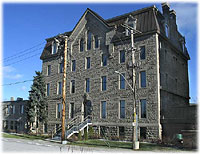The Notre-Dame-de-Grâce Presbytery
Notre-Dame-de-l'Île Street

The first Catholic parish in Hull arose from a need to serve the lumberjacks and log drivers from the Ottawa River logging camps. In 1846, the Community of the Oblates of Mary Immaculate, some of whose missionaries had arrived in the country around 1840, asked Ruggles Wright for two lots to build a chapel near Hull Landing. He gave them the land. The "Lumbermen's Chapel", built by the missionary Eusèbe Durocher, was not only a place for religious services, but also an inn for raftsmen.
In 1868, a stone church was built according to the plans of the architect Lecours, and the chapel was converted into a school. The Reverend Georges Bouillon, architect of the Rideau Street Convent Chapel displayed in the National Gallery of Canada, and the Saint-Francois-de-Sales Church in Pointe-Gatineau, designed the interior of the church dedicated to Notre-Dame-de-Grâce (Our Lady of Grace). In 1870, the Oblates purchased from J. P. Lawless all the remaining lots on the island between Papineau, Laurier, Victoria and Notre-Dame Streets. Two years later, they acquired 130 acres near Brewery Creek, established a Catholic cemetery there, and transferred the bodies interred near the original chapel. A presbytery was built on the site. The church and the presbytery burned down in the district fire of June 1888.
In spring 1889, the architects Roy and Gauthier of Sorel were hired to design a new church and its presbytery. For the next three years, the priests officiated at the Oeuvre de la jeunesse (Youth Workers Order) house, on Albion (Dollard) Street, and then in August 1891, in the basement of the church, which opened on December 25, 1892. The 80-metre bell tower of "the most beautiful church in the diocese" dominated the entire city. At the turn of the century, it served a population of about 12,000 souls, the majority of whom were francophones. As if to complete the dismantling of the social fabric, after the neighbourhood houses were replaced by office towers, the Notre-Dame Church burned down on September 12, 1971. No attempt was made to save it. The following year, its stone walls were demolished. Only the presbytery, built in 1889, has survived the wave of demolition.
For this presbytery, bigger than its predecessor, the Montreal firm Pronovost, Turcot and Martineau was hired for the masonry work, and Joseph Bourque of l' Assumption for the interior wood finishes. Bourque then settled in Hull, on Notre-Dame Street, and became one of the main entrepreneurs in the city, as well as the mayor.
As the presbytery was ready before the church, the priests took possession of it on December 21, 1889. It was large, spacious, airy, convenient, well heated and well located. The presbytery, along with the church, the outbuildings housing a janitor and his family, a small garden and a lawn guarded by the statue of Mary Immaculate, comprised a complex that covered 12 lots, bordered by four streets. In 1904, the presbytery accommodated 27 monks, often missionaries working in the countryside or teaching in the city's schools. The cooking and domestic service of the house were entrusted to three young women, while the lay brothers took charge of the sacristy, the church, and the garden. The missionaries had access to a library where they could study, and prepare their lessons and their theological lectures.
The Notre-Dame-de-Grâce Church and its presbytery escaped the Great Fire of 1900. An oblate who witnessed the disaster reported that only the presbytery, the church, both convents of the Grey Nuns, the Pacific Railway station and all its outbuildings were spared from the flames. However, as numerous other witnesses testified, he neglected to mention the survival of houses, less than ten years old, in the area around the church.
After the demolition of the church, the presbytery was sold, in May 1975, to the company Place Notre-Dame Limitée. In 1976, they rented the premises to the University of Quebec. The Four Points Hotel renovated the building in 2003 and received the prix orange award from the Outaouais Historical Society for its contribution to heritage preservation. The hotel uses the building as a conference centre.
|